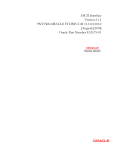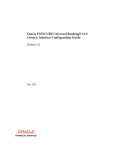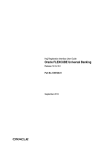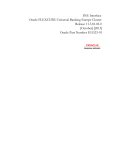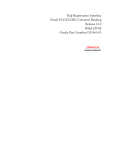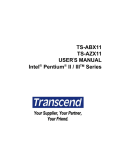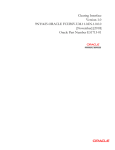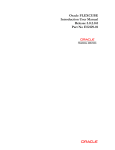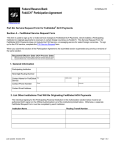Download Clearing Interface User Manual
Transcript
Clearing Interface Oracle FLEXCUBE Universal Banking Release 11.3.83.02.0 [April] [2014] Oracle Part Number E53607-01 Clearing Interface Table of Contents 1. ABOUT THIS MANUAL................................................................................................................................ 1-1 1.1 1.2 1.3 1.4 1.5 1.6 1.7 2. INTRODUCTION ........................................................................................................................................... 1-1 AUDIENCE .................................................................................................................................................. 1-1 ACRONYMS AND ABBREVIATIONS .............................................................................................................. 1-1 ORGANIZATION .......................................................................................................................................... 1-1 CONVENTIONS USED IN THIS MANUAL ....................................................................................................... 1-1 GLOSSARY OF ICONS .................................................................................................................................. 1-2 RELATED DOCUMENTS ............................................................................................................................... 1-3 THE ASCII CLEARING INTERFACE ........................................................................................................ 2-1 2.1 INTRODUCTION ........................................................................................................................................... 2-1 2.2 MAINTAINING DERIVED UDFS ................................................................................................................... 2-2 2.3 MAINTAINING TRANSACTION TYPE HAND-OFF FILE FORMATS ................................................................... 2-3 2.4 MESSAGE UPLOAD ..................................................................................................................................... 2-5 2.4.1 Viewing the details of Files that were Handed-off ............................................................................. 2-7 2.5 PROCESSING FOR THE INTERFACE ............................................................................................................... 2-7 2.5.1 Incoming Message Processing ........................................................................................................... 2-7 2.5.2 Outgoing Message Processing ........................................................................................................... 2-8 2.6 HANDLING OUTWARD CLEARING BATCH ................................................................................................... 2-9 2.6.1 File Format ........................................................................................................................................ 2-9 2.7 RETURNING OR REVERSING OF OUTWARD CLEARING .............................................................................. 2-11 2.8 PROTESTING OR REVERSING OF CHEQUE DETAILS ................................................................................... 2-11 2.9 CLEARING INWARD AND INTERNAL TRANSACTIONS ................................................................................ 2-12 2.9.1 File Format ...................................................................................................................................... 2-13 2.10 REVERSING OF INWARD CLEARING FOR CHEQUE AND DD ....................................................................... 2-14 3. SCREEN GLOSSARY .................................................................................................................................... 3-1 3.1 FUNCTION ID LIST...................................................................................................................................... 3-1 1. About this Manual 1.1 Introduction This manual is designed to help acquaint you with the interface between Oracle FLEXCUBE and the relevant clearing networks. Placing the cursor on the relevant field and striking the <F1> key on the keyboard can obtain information specific to a particular field. 1.2 Audience This manual is intended for the following User/User Roles: 1.3 1.4 Role Function Back office data entry Clerks Input functions for maintenance related to the interface Back office Managers/Officers Authorization functions Acronyms and Abbreviations Abbreviation Description System Unless and otherwise specified, it shall always refer to Oracle FLEXCUBE system UDF User Defined Fields ACH Automated Clearing House Organization This document talks about the maintenance required for data exchange between Oracle FLEXCUBE and the relevant clearing networks. This includes the following Maintaining Clearing Message Types Maintaining File Formats Maintaining Clearing Message Groups Derived and Rejection UDF Maintenance Message Status Browser The manual also talks about the following processes: Message hand-off to the clearing network Message upload into Oracle FLEXCUBE Online message processing 1.5 Conventions Used in this Manual Important information is preceded with the symbol. 1-1 1.6 Glossary of Icons This User Manual may refer to all or some of the following icons: Icons Function New Copy Save Delete Unlock Print Close Re-open Reverse Template Roll-over Hold Authorize Liquidate Exit Sign-off Help Add row Delete row Option List Confirm 1-2 Icons Function Enter Query Execute Query Refer the Procedures User Manual for further details about the icons. 1.7 Related Documents You can refer to the XML Interface document, which outlines the details of the interface mechanism between Oracle FLEXCUBE and an External System. 1-3 2. The ASCII Clearing Interface 2.1 Introduction The Local Payments module supports the local clearing of payments. The Oracle FLEXCUBE Clearing Gateway is the common channel for data exchange between Oracle FLEXCUBE and the local clearing networks applicable. The ACH Network is an electronic payments network used by individuals, businesses, financial institutions and government organizations. Electronic ACH payments provide better cash management capabilities and lower costs than traditional paper payments. Both funds and information may be exchanged between financial institutions on behalf of companies and individuals utilizing electronic payments. The ACH Network allows funds to be electronically credited or debited to a Company or individual's deposit account. Currently these deposit accounts include checking, savings, loan and financial institution general ledger accounts. The following information can be transmitted through ACH transactions: the name of the account holder the financial institution’s routing number the account number involved in the transaction the party initiating the transaction and the amount the date of the transaction A Data Diagram which illustrates the work-flow Originator Authorizer Receiver Automated Clearing House ODFI – Originating RDFI – Receiving Depository Financial Institution Depository Financial Institution The data exchange of messages will be in the form of ASCII file formats. For the interface to function effectively, you need to maintain certain basic information in Oracle FLEXCUBE. This includes the following: 2-1 Maintaining Clearing Transaction Types Maintaining Interface hand-off file formats for individual transaction types Maintaining Clearing Transaction Groups for transaction type 2.2 Maintaining Derived UDFs As part of maintenance, you have to establish a mapping between the Local Payments module of Oracle FLEXCUBE to fields that are required by the clearing network. In other words, Oracle FLEXCUBE tags are mapped to the corresponding external system tags. Sometimes, you may not find a direct relationship between an external system tag and the Oracle FLEXCUBE tags. For such tags, with no corresponding tags in Oracle FLEXCUBE, you can define an UDF (User Defined Field) and obtain a value by writing derivation logic. Likewise, you can also write rejection logic. If a particular contract in the hand-off message satisfies the rejection criteria, the system will reject the entire contract. The rejection logic will filter the contracts within the message that is being handed-off. During mapping, you can map the external tag with the corresponding UDF name. Example The external system may have a tag called – Account Type. A corresponding tag does not exist in Oracle FLEXCUBE. Instead, Oracle FLEXCUBE has a tag called ‘Account_No’. Therefore, to obtain a value for ‘Account Type’, you can derive a logic such that if the first character of the Account No. is ‘C’, the Account Type would be ‘Normal’ else it will be considered as a ‘Special’ account. Therefore, when you actually handoff a message, the Account Type would be associated with the value ‘Normal’ or ‘Special’ as the case may be. You can maintain the UDFs in the ‘Incoming ASCII Derived UDF ’ screen. You can invoke this screen by typing ‘IFDRVUDF’ in the field at the top right corner of the Application tool bar and clicking the adjoining arrow button. 2-2 In this screen, you have to specify the following details: UDF Name and UDF Description You can specify a unique name to identify the UDF. A brief description can also be provided in the adjacent field. UDF Type Additionally, you should also specify the type of the UDF being defined – whether you are writing a logic to derive a tag value or for filtering the transactions (in a message file) based on a rejection criteria. Network Specify the network for which you are writing the derivation/rejection logic. To execute the logic, click on the ‘X’ button. If you encounter any error during execution, you can view the same by clicking on the ‘E’ button. Make the necessary corrections before you reexecute the logic. The UDFs defined through this screen will be available in the drop-down menu of the ‘Derive Type’ field in the ‘Clearing Message Type’/’Group Details Maintenance’ screen. This is discussed in the section that follows. You can maintain only 25 derived logics (UDFs) for all the networks that are applicable for data exchange with Oracle FLEXCUBE. Likewise, you can maintain only one rejection logic per network. 2.3 Maintaining Transaction Type hand-off file formats Each network and clearing message type/category has a fixed format that needs to be handed off from or uploaded into Oracle FLEXCUBE. Therefore you will need to specify the format in which data is to uploaded and handed-off. 2-3 You can do this through the ‘Format Maintenance’ screen. You can invoke this screen by typing ‘GIDIFTDF’ in the field at the top right corner of the Application tool bar and clicking the adjoining arrow button. Through this screen you can establish a mapping between the Local Payments module of Oracle FLEXCUBE to fields that are required by the network. A predefined set of Clearing Message Types will be shipped along with the software. You can change the default attributes of these message types to suit the requirements of your bank. The file header marks the beginning of a file. Every batch begins with a batch header and ends with the batch footer. The batch body is the actual content of the message that is being handed off or uploaded. The file footer marks the end of the file. A file can consist of several file headers, file footers, batch footers and so on. You can maintain a format for each occurrence of a format type within the ASCII file. Number Padding/Direction The messages that are uploaded to or handed-off from Oracle FLEXCUBE consists of fields of a specific length. Most often, the maximum field length is not utilized when you capture the actual field values. Therefore, you need to specify a padding character to fill the gaps. You also need to indicate the direction of the padding characters – whether you would like to pad to the left of the actual field value or to its right. Normally, for numeric fields, you would choose to pad to the left of the numeric value. Example Assume that the length of a numeric field, say ‘Amount’ is 10 and the actual field value is ‘100’, consisting of only 3 digits. Further, you select ‘0’ (zero) as the padding character and choose to pad to the left of the field value. 2-4 If the message consists of this numeric field, zero will be used to fill the gaps and the value will be displayed as: ‘0000000100’. Alpha Padding/Direction Similarly, you have to select the padding character for the alphanumeric fields in Oracle FLEXCUBE. You also need to indicate the padding direction for the same. Normally, for alphanumeric fields, you would choose to pad to the right of the actual value. Format Type As stated earlier, the messages that are handed off and uploaded into Oracle FLEXCUBE are in the ASCII file format. An ASCII file consists of the following sections (in the order specified): 1. File Header 2. Batch Header 3. Batch Body 4. Batch Footer 5. File Footer You can maintain a format for each section of the ASCII file. The file header marks the beginning of a file. Every batch begins with a batch header and ends with the batch footer. The batch body is the actual content of the message that is being handed off or uploaded. The file footer marks the end of the file. A file can consist of several file headers, file footers, batch footers and so on. You can maintain a format for each occurrence of a format type within the ASCII file. Length check required You have the option to indicate whether you want to calculate the length of each line in the file. If you specify that line check is required, you can maintain line attributes such as start position and length for the clearing message group in the ‘Clearing Msg Group Maintenance’ screen explained later in this manual. Date and Time Format For date related fields, you need to identify the format in which the date value will be sent from and received into Oracle FLEXCUBE. By default, Oracle FLEXCUBE sends all date fields in ‘RRRRMMDD’ format. Similarly, for time related fields you have to identify the format in which the time value is to be sent from and received into Oracle FLEXCUBE. For instance, you can maintain a format like HHMMSS. This format will continue to apply for the entire line of the message format. For more information on ‘Interface Definition Screen’ please refer to the ‘Interface Definition Details’ section of ‘Generic Interface’ user manual. 2.4 Message Upload Just like the hand-off process, the upload process too needs to be manually triggered from Oracle FLEXCUBE. 2-5 You can trigger the message upload event through the ‘Interface Triggering’ screen invoked from the Application Browser. You can invoke this screen by typing ‘GIDIFPRS’ in the field at the top right corner of the Application tool bar and clicking the adjoining arrow button. In this screen, you need to identify the network and the message group for which the message needs to be uploaded. If you do not want to use the file path specified for the Message Group, you can enter a different path here. This path will take precedence over the one maintained for the Message Group. The five folders (mentioned earlier) will be created in the file path specified in this screen. After you trigger the upload process, the system will pick up the ASCII file from the ‘in’ folder and move it to the ‘wip’ area. It retains a copy of the file in the ‘fcc’ -area as backup. For more information on ‘Interface Triggering’ please refer to the ‘Message Upload’ section of ‘Generic Interface’ user manual. 2-6 2.4.1 Viewing the details of Files that were Handed-off You can view the details of all files that were handed-off through the ‘File Status Log’ screen. You can invoke the ‘Status Browser’ screen by typing ‘IFDFILOG’ in the field at the top right corner of the Application tool bar and clicking the adjoining arrow button. You can either choose to view the details of files with a particular status or view the details of all files that were handed-off. The details of each file within a network will be displayed in a different color depending on its status. For instance, a file with errors will be displayed in red. Double click on a file to view the details of contracts included in it. 2.5 Processing for the Interface The interface can either be Online or in a Batch format. For the online mode each contract in Oracle FLEXCUBE will be handed off as a separate file. 2.5.1 Incoming Message Processing While processing incoming messages, contracts are uploaded using the following process stages: You will initiate the process of uploading files. The system checks if any recovery operation is required. If required, it is handled first. The file name is logged into the log table before the contents of the file are processed. The file name can be used for recovery and reporting. After this, the entire file is read into memory in chunks. The key identifier for the message is derived from the position and the number of characters maintained at the file level. For the Identifier thus derived, the subsequent details are picked from the message maintenance. Next, the system processes each line and populates it into a row type. Whenever the beginning of a new contract is found, the system inserts the row type into the corresponding table with a particular flag. This process goes on till the end of file is reached. The following totals will be kept for each file (driven by a flag) Total for Debits 2-7 Total for Credits Total for Accounts Total of Amounts No of Records in the Message After processing all the records, the file is moved into the ‘fcc’-area. All the status for the contracts uploaded will be changed for booking and these data are processed using a batch function. 2.5.2 Outgoing Message Processing While processing outgoing messages, the following stages are involved in the creation of Clearing files: You will have to specify the File / Clearing Message Type that needs to be created On initiation, the system first checks if there is any recovery operation is required. If required, it is handled first. For the given clearing message type, all products for which the file needs to be created will be picked up from the Product Mapping- Clearing Message Type maintenance. Since it is possible for the file to have a batch grouped on an account too, the system will pick up the corresponding flag for the file. The system will select the relevant records from the Message Maintenance for a given message type. The file level attributes that are maintained will be picked up from File/Clearing Message Type. These are: File Name File Extension File Path Session Timeout Number of Resends Number of Transactions in a file Number of Transaction in a Batch Contracts pertaining to each product selected from the Product Mapping- Clearing Message Type maintenance will be picked up for processing for the Clearing File. The sequence that is followed during the processing is: File Header Records (FH) Message Header Records (MH) Message Records (MR) Message Footer Records (MF) File Trailer Records (FF) The following batch totals are assumed for the trailer records: Total for Accounts Total of Amounts No of Records in the Message Each record is locked before the data in the record is processed. If the record is locked successfully, then the details of the record are passed on to the Business Rule layer to update the record to the dispatch status. 2-8 Based on the flag passed from the Business layer, the message is formatted on the basis of the maintenance done. A preset number of contracts is processed and committed and written to the file based on the maintenance done. After all the contracts are processed the file is moved to the area specified in the maintenance. The above processes are also responsible for converting the data formats and tag formats from the Oracle FLEXCUBE standard format to the formats as required by the external systems. The above set of processes also translates the fields that require a translation as per the maintenance for the particular interface. 2.6 Handling Outward Clearing Batch Oracle FLEXCUBE allows you to deposit checks into your account. You can also make various module payments such as paying loans using checks or other instruments. Your bank will process the checks deposited in ATM, which in turn will send these checks to the external agency. This external agency also collects the checks directly from companies or from customer home or collection centers and then processes these checks and creates an outward clearing transaction file. An outward clearing input file will have the following details: Internal clearing transactions Outward clearing transactions for Metropolitan region and other regions Various clearing details of outward clearing checks that are used for payment against an obligation Deposits can be in Current account or in saving accounts Header and trailer for the file 2.6.1 File Format The clearing file format consists two fields ‘Record Type’ and ‘Transaction Code’ where ‘Record type’ indicates the type of transaction to be processed. Transaction code indicates ‘D’ for ‘Debit Adjustment’ and ‘C’ for ‘Credit Adjustment’ transactions. The clearing file consists of the following transaction type records: Transaction Type V Transaction Type T Transaction Type D Transaction Type V This type of transaction indicates various payments, such as payment of loans. It will be ignored and will not be processed. Transaction Type T This type of transaction indicates adjustment entry record. The records with transaction type T and transaction code indicator as D are identified as Debit Adjustment to the customer account, i.e. the customer account will be debited to that extent. The records with transaction type T and transaction code indicator as C are identified as Credit Adjustment to the customer account. 2-9 Transaction Type D This type of transaction indicates the details of Deposit Slip with individual check details. The system will process the clearing transaction with Type ‘D’ to create clearing transaction by grouping at a deposit slip. The interface file format of an outward clearing input file is as follows: External Tag Name Description Oracle FLEXCUBE Field Name Starting Position Ending Position Data Length Data Type EXT_ACCOUNT External Account EXT_ACCOUNT 1 20 20 V INSTRNO2 Instrument Number 2 INSTRNO2 21 36 16 V INSTRNO Instrument Number INSTRNO 37 52 16 V REMBANK Remitter Bank REMBANK 53 61 9 V SECTOR_CODE Sector Code SECTOR_CODE 62 70 9 V DOCUMENT_TYPE Document Type DOCUMENT_TYPE 71 90 20 V INSTRAMT Instrument Amount INSTRAMT 91 115 25 N BENACCOUNT Beneficiary Account BENACCOUNT 116 135 20 V ACCOUNT_TYPE Account Type ACCOUNT_TYPE 136 138 3 V TXN_BRN Transaction Branch TXN_BRN 139 141 3 V CLEARING_TYPE Clearing Type CLEARING_TYPE 142 143 2 V RECORD_TYPE Record Type RECORD_TYPE 144 144 1 V TRN_CODE Trasaction Code TRN_CODE 145 146 2 N BUNDLE_ID Bundle Id BUNDLE_ID 147 162 16 V LOCAL_CLEARING Local Clearing LOCAL_CLEARING 163 163 1 V DEPOSIT_PLACE Deposit Place DEPOSIT_PLACE 164 183 20 V INSTRDATE Instrument Date INSTRDATE 184 191 8 D 2-10 INSTRCCY Instrument Currency INSTRCCY 192 194 3 V BENBRANCH Beneficiary Branch BENBRANCH 195 197 3 V REMACCOUNT Remitter Account REMACCOUNT 198 217 20 V REMBRANCH Remitter Branch REMBRANCH 218 220 3 V OPERATION_CODE Operation Code OPERATION_COD E 221 230 10 V ADDL_RETENTION_D AYS Additional Retention Days ADDL_RETENTIO N_DAYS 231 233 3 N LOT_CORELATIV_NO Correlative Number LOT_CORELATIVE _NO 234 249 16 V BENBANK Beneficiary Bank BENBANK 250 258 9 V SCODE Source Code SCODE 259 273 15 V XREF External Ref Number XREF 274 291 18 V ENTRY_NO Entry Serial Number ENTRY_NO 292 300 9 N 301 303 2 N NUM_SEQ 2.7 Returning or Reversing of Outward Clearing Oracle FLEXCUBE allows you to return the outward clearing in outward return input file. This file contains all the outward clearing checks of normal clearing. If the clearing contract has been booked on the same day, then from ‘Cheque Return’ screen, the completed list of the transactions can be selected and reversed. ASCII outward clearing file format is used to upload the reversal of outward clearing upload having Clearing type as outward clearing and by specifying the SCODE, XREF, and entry number of the original clearing transaction to be reversed. ASCII outward clearing file format is used to upload the return of outward clearing having records clearing type as OP- indicating Outward clearing return. 2.8 Protesting or Reversing of Cheque Details Oracle FLEXCUBE receives a file from an external agency to protest bank cheques having issues like debit account with invalid status, cheque with forms and signature issues. The file will have the details of the cheque and tax details to be collected from the debit account. 2-11 The upload will be handled based on the flags, Action_code and Protest_type. Bank cheque will be protested for Action_code='P' and Protest_type='P' .Reversal of the protest happens for Action_code='R' and Protest_type='R'. 2.9 Clearing Inward and Internal Transactions Oracle FLEXCUBE allows you to deposit the internal check at the teller counter by passing an online referential entry. The check details will then be handed over to the external agency which in turn creates a batch file. The batch file creates internal clearing transaction for bank checks. For internal checks present in the input file, the system will create a retail teller contract with retention and value date as the value date of the transaction. The external agency will send the details of bank checks presented at other banks as a batch file, which in turn creates an inward clearing transactions. 2-12 2.9.1 File Format Oracle FLEXCUBE uses outward ASCII file format for internal clearing. Internal clearing Product is picked up from the Clearing Product maintenance at bank level. The interface file format of an inward clearing input file is as follows: External Tag Name Description BDY Oracle FLEXCUBE Field Name Starting Position Ending Position Data Length Data Type Body 1 3 3 V NUM_SEQ Number Sequence 4 5 2 V EXT_ACCOUNT External Account BENACCOUNT 6 25 20 V INSTRNO2 Instrument Number 2 INSTRNO2 26 41 16 V INSTRNO Instrument Number INSTRNO 42 57 16 V BENBANK Beneficiary Bank BENBANK 58 66 9 V SECTOR_CODE Sector Code SECTOR_CODE 67 75 9 V DOCUMENT_TYPE Document Type DOCUMENT_TYPE 76 95 20 V INSTRAMT Instrument Amount INSTRAMT 96 120 25 N INSTRCCY Instrument Currency INSTRCCY 121 123 3 V REM_ACCOUNT Remitter Account REMACCOUNT 124 143 20 V ACCOUNT_TYPE Account Type ACCOUNT_TYPE 144 146 3 V TXN_BRN Transaction Branch TXN_BRN 147 149 3 V CLEARING_TYPE Clearing Type CLEARING_TYPE 150 151 2 V DEPOSIT_PLACE Deposit Place DEPOSIT_PLACE 152 163 12 V 2-13 External Tag Name Description Oracle FLEXCUBE Field Name Starting Position Ending Position Data Length Data Type ENTRY_NO Entry Number ENTRY_NO 164 171 8 V INSTRDATE Instrument Date INSTRDATE 172 179 8 D 180 182 3 V INSTRCCYNOTMAPPED REMBRANCH Remitter Branch REMBRANCH 183 185 3 V ENDORSABLE Endorsable/ NonEndorsable ENDORSABLE 186 186 1 V BENNAME Beneficiary Name BENDETAILS1 187 290 104 V RECORD_TYPE Record Type RECORD_TYPE 291 291 1 V HOUSE_LOCATION Clearing House BRANCH_CODE 292 295 4 V DOC_TRACK_NUM Document Tracking Number 296 310 15 V BENBRANCH Beneficiary Branch BENBRANCH 311 313 3 V SCODE Source Code SCODE 314 328 15 V XREF External Reference Number XREF 329 344 16 V 2.10 Reversing of Inward Clearing for Cheque and DD Oracle FLEXCUBE allows you to reverse the inward clearing contract. You can select the set of inward clearing transactions from the complete list of transactions and then reverse it, provided, if the contract has been booked on the same day. Inward clearing reversal upload will reverse the module level transactions in case of clearing contract created by DD module. ASCII inward clearing file format is used to upload the Inward clearing Reversal having records clearing type as Inward Clearing as IP- indicating Inward clearing return and by mentioning the SCODE , XREF and Entry number. If the document type is DD, the system will trigger reversal of the DD liquidation. 2-14 3. Screen Glossary 3.1 Function ID List The following table lists the function id and the function description of the screens covered as part of this User Manual. Function ID Function Description IFDRVUDF Incoming ASCII Derived UDF ’ GIDIFTDF Format Maintenance GIDIFPRS Interface Triggering IFDFILOG File Status Log 3-1 Clearing Interface [April] [2014] Version 11.3.83.02.0 Oracle Financial Services Software Limited Oracle Park Off Western Express Highway Goregaon (East) Mumbai, Maharashtra 400 063 India Worldwide Inquiries: Phone: +91 22 6718 3000 Fax:+91 22 6718 3001 www.oracle.com/financialservices/ Copyright © 2005, 2014, Oracle and/or its affiliates. All rights reserved. Oracle and Java are registered trademarks of Oracle and/or its affiliates. Other names may be trademarks of their respective owners. U.S. GOVERNMENT END USERS: Oracle programs, including any operating system, integrated software, any programs installed on the hardware, and/or documentation, delivered to U.S. Government end users are ‘commercial computer software’ pursuant to the applicable Federal Acquisition Regulation and agency-specific supplemental regulations. As such, use, duplication, disclosure, modification, and adaptation of the programs, including any operating system, integrated software, any programs installed on the hardware, and/or documentation, shall be subject to license terms and license restrictions applicable to the programs. No other rights are granted to the U.S. Government. This software or hardware is developed for general use in a variety of information management applications. It is not developed or intended for use in any inherently dangerous applications, including applications that may create a risk of personal injury. If you use this software or hardware in dangerous applications, then you shall be responsible to take all appropriate failsafe, backup, redundancy, and other measures to ensure its safe use. Oracle Corporation and its affiliates disclaim any liability for any damages caused by use of this software or hardware in dangerous applications. This software and related documentation are provided under a license agreement containing restrictions on use and disclosure and are protected by intellectual property laws. Except as expressly permitted in your license agreement or allowed by law, you may not use, copy, reproduce, translate, broadcast, modify, license, transmit, distribute, exhibit, perform, publish or display any part, in any form, or by any means. Reverse engineering, disassembly, or decompilation of this software, unless required by law for interoperability, is prohibited. The information contained herein is subject to change without notice and is not warranted to be error-free. If you find any errors, please report them to us in writing. This software or hardware and documentation may provide access to or information on content, products and services from third parties. Oracle Corporation and its affiliates are not responsible for and expressly disclaim all warranties of any kind with respect to third-party content, products, and services. Oracle Corporation and its affiliates will not be responsible for any loss, costs, or damages incurred due to your access to or use of third-party content, products, or services.





















